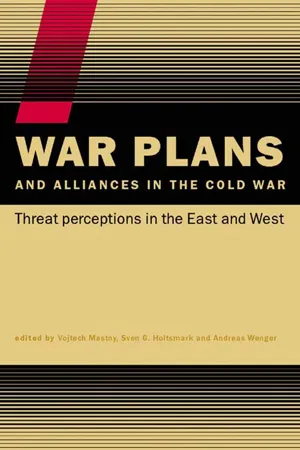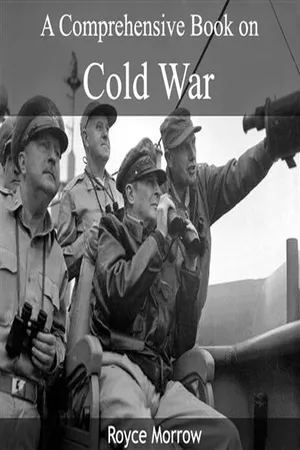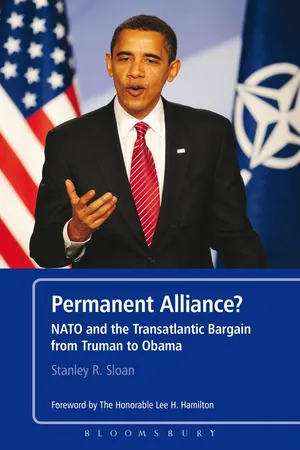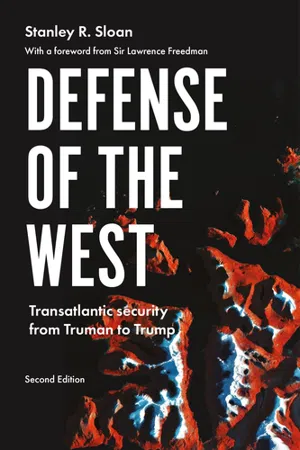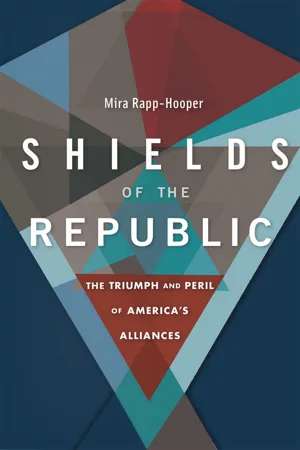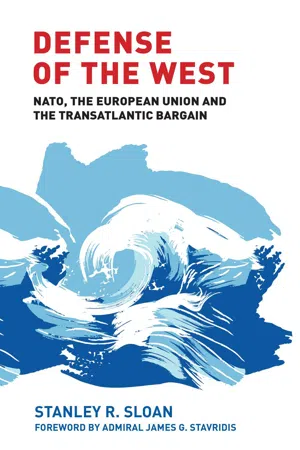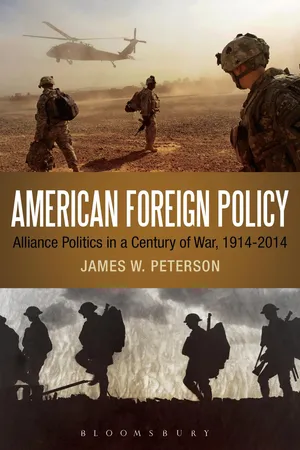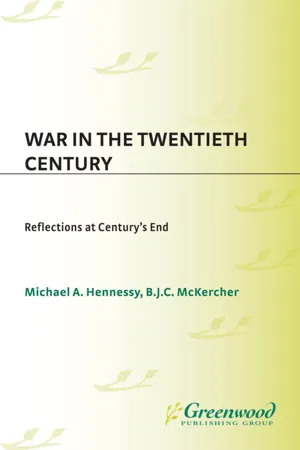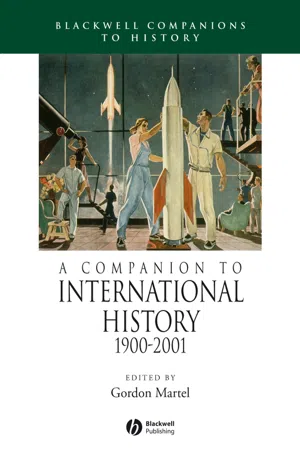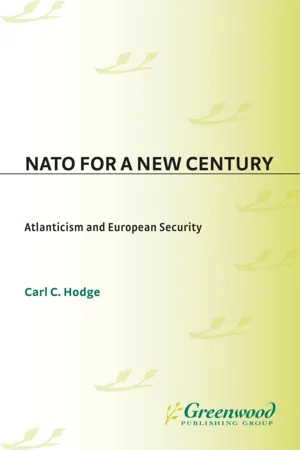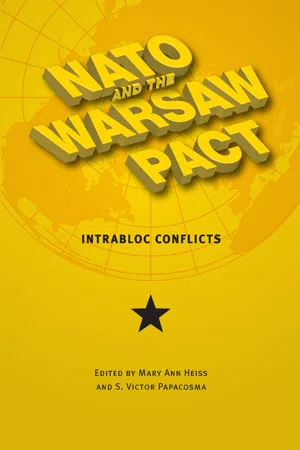History
Cold War Alliances
The Cold War alliances refer to the two main military and political blocs that emerged after World War II: the North Atlantic Treaty Organization (NATO) led by the United States and the Warsaw Pact led by the Soviet Union. These alliances represented the division between the capitalist Western bloc and the communist Eastern bloc, shaping global politics and security dynamics during the Cold War era.
Written by Perlego with AI-assistance
Related key terms
1 of 5
12 Key excerpts on "Cold War Alliances"
- eBook - ePub
War Plans and Alliances in the Cold War
Threat Perceptions in the East and West
- Vojtech Mastny, Sven S. Holtsmark, Andreas Wenger, Vojtech Mastny, Sven S. Holtsmark, Andreas Wenger(Authors)
- 2013(Publication Date)
- Routledge(Publisher)
IntroductionNew perspectives on the Cold War Alliances
Vojtech MastnyThis is a book about a history made fresh by the decay of the Western alliance aggravated by disputes about the Iraq War. The history is that of the alliance and its former rival — the Warsaw Pact — during the Cold War, and the freshness is in what the story tells us about two important topics addressed in the book in a historical perspective. The first is military threats and their perceptions as well as misperceptions, along with the war plans that were drawn as a result. The second is the management of the alliances that were formed to cope with those real or imaginary threats — the Western alliance that has survived, albeit with clouded future, and the Soviet one that has disintegrated.The twelve studies that comprise the book have not been written to draw lessons but are well suited the make the reader draw them. The research was originally undertaken for a conference intended to review the threat perceptions, military doctrines, and war plans during the Cold War from the post-Cold War perspective. The conference was organized by the Norwegian Institute for Defense Studies as a partner in the Parallel History Project (PHP) on NATO and the Warsaw Pact — an international scholarly network dedicated to the study of the Cold War's military aspects and their political implications. It met in June 2003 — three months after the Iraq war started — in Longyearbyen on Norway's Spitzbergen islands.A committee, consisting of the three editors of the present volume, has selected the twelve essays from among the twenty-six prepared for the conference. The original texts were first reviewed, then rewritten, and finally edited in several stages according to the editors' guidelines, to emphasize what is new and important in the larger picture. It is for this reason that the resulting presentations, now printed here, illuminate some of the main issues that darken the American— European alliance relationship fifteen years after the Cold War had been won. Three fourths of the presentations are by Europeans. - No longer available |Learn more
- (Author)
- 2014(Publication Date)
- Learning Press(Publisher)
______________________________ WORLD TECHNOLOGIES ______________________________ Chapter- 4 Cold War (1953–1962) 1962 World map of alignments: NATO member states Other allies of the USA Colonized countries Warsaw Pact member states Other allies of the USSR Non-aligned nations The Cold War (1953–1962) discusses the period within the Cold War from the death of Soviet leader Joseph Stalin in 1953 to the Cuban Missile Crisis in 1962. Following the death of Stalin unrest occurred in the Eastern Bloc, while there was a calming of international tensions, the evidence of which can be seen in the signing of the Austrian State Treaty reuniting Austria, and the Geneva Accords ending fighting in Indochina. However, this thaw was only partial with an expensive arms race continuing during the period. ______________________________ WORLD TECHNOLOGIES ______________________________ Eisenhower and Khrushchev When Dwight D. Eisenhower was sworn in as U.S. President in 1953, the Democrats lost their two-decades-long control of the U.S. presidency. Under Eisenhower, however, the United States' Cold War policy remained essentially unchanged. Whilst a thorough rethinking of foreign policy was launched (known as Operation Solarium), the majority of emerging ideas (such as a rollback of Communism and the liberation of Eastern Europe) were quickly regarded as unworkable. An underlying focus on the containment of Soviet communism remained to inform the broad approach of U.S. foreign policy. An important strand in American politics of this period was McCarthyism. Named after Wisconsin Senator Joseph McCarthy, this was a period of intense anti-communism which lasted from 1948 to about 1956. The government of the United States prosecuted the leadership of the Communist Party USA as well as other individuals suspected of being communists. McCarthy's career faltered in 1954 as his hearings were televised for the first time, allowing the public and press to view his tactics. - eBook - ePub
Permanent Alliance?
NATO and the Transatlantic Bargain from Truman to Obama
- Stanley R. Sloan(Author)
- 2010(Publication Date)
- Continuum(Publisher)
Part ICold War Alliance
Passage contains an image
Chapter 1
The Bargain as a Framework for Analysis
The glue that has held the allies more or less together is a large, complex and dynamic bargain—partly an understanding among the Europeans, but mostly a deal between them and the United States of America.—Harlan Cleveland , NATO : The Transatlantic Bargain1Crafted in the late 1960s, Harlan Cleveland’s description of NATO as a “transatlantic bargain” remains, in the early years of the twenty-first century, a helpful prism through which to analyze the North Atlantic alliance. Cleveland, a former US permanent representative to NATO, knew the alliance was far more than the sort of deal struck between business partners. Although the transatlantic bargain is based firmly on unsentimental calculations of national self-interest on both sides of the Atlantic, it also depends on some amorphous but vital shared ideas about man, government, and society. It is a “bargain,” to be sure, but a bargain with roots in the hearts (and values) as well as in the minds (and interests) of the partners.The United Kingdom’s Lord Palmerston, a nineteenth-century British statesman, famously declared that “Nations have no permanent friends or allies, they only have permanent interests.” Palmerston’s observation stood up well through the mid-twentieth century. However, the persistence of the North Atlantic Treaty Organization—the leading component of the transatlantic bargain—seems to be challenging Palmerston’s assertion.From George Washington’s warning in his farewell address that the United States should avoid permanent foreign alliances, particularly with European states, the United States followed his advice—until April 1949, when the North Atlantic Treaty was signed. As Lawrence S. Kaplan has observed, “The Europeans may have initiated the process, but bipartisan U.S. advocates brought it to a conclusion and terminated America’s 149-year tradition of political and military non-entanglement with Europe.”2 - eBook - ePub
Defense of the West
Transatlantic security from Truman to Trump, Second edition
- Stanley R. Sloan(Author)
- 2020(Publication Date)
- Manchester University Press(Publisher)
Part I Cold War alliancePassage contains an image 1 The transatlantic bargain and defense of the West
The glue that has held the allies more or less together is a large, complex and dynamic bargain—partly an understanding among the Europeans, but mostly a deal between them and the United States of America. (Harlan Cleveland, NATO: The Transatlantic Bargain)1Crafted in the late 1960s, Harlan Cleveland’s description of the North Atlantic Treaty Organization (NATO) as a “transatlantic bargain” remains, in the early years of the twenty-first century, a helpful prism through which to analyze the North Atlantic alliance. Cleveland, a former US permanent representative to NATO, knew the alliance was far more than the sort of deal struck between business partners. Although the transatlantic bargain is based firmly on unsentimental calculations of national self-interest on both sides of the Atlantic, it also depends on some amorphous but vital shared ideas about man, government, and society. It is a “bargain,” to be sure, but a bargain with roots in the hearts (and values) as well as in the minds (and interests) of the partners. Because this alliance serves both values and interests, it has come to represent the primary framework for defense of “the West.”The United Kingdom’s Lord Palmerston, a nineteenth-century British statesman, famously declared that “Nations have no permanent friends or allies, they only have permanent interests.” Palmerston’s observation stood up well through the mid-twentieth century. However, the persistence of NATO—the leading component of the transatlantic bargain—seems to be challenging Palmerston’s assertion.Following George Washington’s warning in his farewell address that the United States should avoid permanent foreign alliances, particularly with European states, the United States took his advice—until April 1949, when the North Atlantic Treaty was signed. As Lawrence S. Kaplan has observed, “The Europeans may have initiated the process, but bipartisan U.S. advocates brought it to a conclusion and terminated America’s 149-year tradition of political and military non-entanglement with Europe.”2 - eBook - PDF
Shields of the Republic
The Triumph and Peril of America’s Alliances
- Mira Rapp-Hooper(Author)
- 2020(Publication Date)
- Harvard University Press(Publisher)
4 ALLIANCES AFTER THE COLD WAR Between 1989 and 1991, America’s principal adversary evaporated. Without war or revolution, and in a tectonic geopolitical shift, the Soviet Union willfully dismantled. The newly minted Russian Fed- eration seemed to pose little threat. It was isolated internationally, its economy in tatters, and in fits and starts it appeared to be making peace with the US-dominated global order. Asia, too, looked favor- able. Washington’s relations with Beijing had been reasonably stable for twenty years, and China was too weak militarily to register as a national security concern. With commanding global power, the United States no longer needed to hold the balance in Europe and Asia to keep itself safe and prosperous. America’s alliances had outlasted the threats they were designed to address, and policymakers would have to decide their fate. Was it time to discard them? Or should alliances be maintained, and perhaps repurposed for this newly auspicious world? For some international relations experts, the idea of salvaging America’s security guarantees in the absence of a major adversary was nonsensical. 1 But many policymakers saw matters differently. Al- liances, they argued, could serve purposes other than deterrence and defense. By anchoring itself to overseas commitments, Wash- ington could make a case for its leadership in a world that no longer seemed to need traditional collective defense. Security guarantees Alliances after the Cold War 103 could help the United States consolidate its Cold War gains and, in Europe, could help to spread liberal democracy. Both outcomes would further a new grand strategy based not on deterrence and defense but on prevention: ensuring that serious competition to American power never arose in the first place. The Clinton administration embraced this new mission, pre- serving and transforming US alliances in the process. - No longer available |Learn more
- (Author)
- 2014(Publication Date)
- College Publishing House(Publisher)
______________________________ WORLD TECHNOLOGIES ______________________________ Chapter 4 Cold War (1953–1962) 1962 World map of alignments: NATO member states Other allies of the USA Colonized countries Warsaw Pact member states Other allies of the USSR Non-aligned nations The Cold War (1953–1962) discusses the period within the Cold War from the death of Soviet leader Joseph Stalin in 1953 to the Cuban Missile Crisis in 1962. Following the death of Stalin unrest occurred in the Eastern Bloc, while there was a calming of international tensions, the evidence of which can be seen in the signing of the Austrian State Treaty reuniting Austria, and the Geneva Accords ending fighting in Indochina. However, this thaw was only partial with an expensive arms race continuing during the period. Eisenhower and Khrushchev When Dwight D. Eisenhower was sworn in as U.S. President in 1953, the Democrats lost their two-decades-long control of the U.S. presidency. Under Eisenhower, however, the United States' Cold War policy remained essentially unchanged. Whilst a thorough rethinking of foreign policy was launched (known as Operation Solarium), the majority of emerging ideas (such as a ______________________________ WORLD TECHNOLOGIES ______________________________ rollback of Communism and the liberation of Eastern Europe) were quickly regarded as unworkable. An underlying focus on the containment of Soviet communism remained to inform the broad approach of U.S. foreign policy. An important strand in American politics of this period was McCarthyism. Named after Wisconsin Senator Joseph McCarthy, this was a period of intense anti-communism which lasted from 1948 to about 1956. The government of the United States prosecuted the leadership of the Communist Party USA as well as other individuals suspected of being communists. McCarthy's career faltered in 1954 as his hearings were televised for the first time, allowing the public and press to view his tactics. - eBook - ePub
Defense of the West
NATO, the European Union and the transatlantic bargain
- Stanley Sloan(Author)
- 2016(Publication Date)
- Manchester University Press(Publisher)
Part ICold War alliance
Passage contains an image
1
The transatlantic bargain and defense of the West
The glue that has held the allies more or less together is a large, complex and dynamic bargain—partly an understanding among the Europeans, but mostly a deal between them and the United States of America. (Harlan Cleveland, NATO: The Transatlantic Bargain)1Crafted in the late 1960s, Harlan Cleveland’s description of the North Atlantic Treaty Organization (NATO) as a “transatlantic bargain” remains, in the early years of the twenty-first century, a helpful prism through which to analyze the North Atlantic alliance. Cleveland, a former US permanent representative to NATO, knew the alliance was far more than the sort of deal struck between business partners. Although the transatlantic bargain is based firmly on unsentimental calculations of national self-interest on both sides of the Atlantic, it also depends on some amorphous but vital shared ideas about man, government, and society. It is a “bargain,” to be sure, but a bargain with roots in the hearts (and values) as well as in the minds (and interests) of the partners. Because this alliance serves both values and interests, it has come to represent the primary framework for defense of “the West.”The United Kingdom’s Lord Palmerston, a nineteenth-century British statesman, famously declared that “Nations have no permanent friends or allies, they only have permanent interests.” Palmerston’s observation stood up well through the mid-twentieth century. However, the persistence of NATO—the leading component of the transatlantic bargain—seems to be challenging Palmerston’s assertion.Following George Washington’s warning in his farewell address that the United States should avoid permanent foreign alliances, particularly with European states, the United States took his advice—until April 1949, when the North Atlantic Treaty was signed. As Lawrence S. Kaplan has observed, “The Europeans may have initiated the process, but bipartisan U.S. advocates brought it to a conclusion and terminated America’s 149-year tradition of political and military non-entanglement with Europe.”2 - eBook - ePub
American Foreign Policy
Alliance Politics in a Century of War, 1914-2014
- James W. Peterson(Author)
- 2014(Publication Date)
- Bloomsbury Academic(Publisher)
In sum, American foreign policy did take shape in a setting of war during the 1945–1991 period. It may have been a war of nerves and a psychological war on in many years, but the United States was nevertheless on a war footing. Defense budgets grew and the nuclear stockpile continued to increase. Continuing stand-offs took place over the city of Berlin from the mid-1950s through the mid-1980s. The symbolic importance of that city during the Cold War was such that U.S. presidential candidate Barack Obama in 2008 chose that location for his major speech on European policy. In many ways, the Cuban Missile Crisis was the watershed event of the period. Soviet intentions to bring the fight to the doorstep of the United States were apparent, but so was the resolve of President Kennedy to risk war in enforcing the blockade and in requiring the removal of the weapons. During this prolonged war spanning forty-six years, alliance politics were continually at the center stage. America’s defense of the city of Berlin was on behalf of its allies in the western part of Europe. Imposition of the blockade around Cuba sent a message of what might happen if similar Soviet probes occurred on the European continent. Development of nuclear weapons was one method for deterring an attack on Western Europe soon after the fall of Eastern Europe to communism. Similarly, arms negotiations included the allies as partners in the discussions and had the purpose of reducing their anxiousness about being so close to the weapons over which Soviet leaders had control. Overall in the period of Cold War, the Atlantic community was the key alliance hope of the period, although there were internal challenges such as that of the French (Kissinger 1963, 261). In particular, the key to success during the Cuban Missile Crisis was the “mobilization of allies” (Chayes 1963, 550).In another way, the period of détente also reopened a kind of alliance between the Soviet Union and the United States. It was an alliance of intentions but also of some formal agreements. In the end, it was a bilateral alliance that supplemented rather than replaced the long decades of connections with traditional allies in Europe. - eBook - PDF
War in the Twentieth Century
Reflections at Century's End
- Michael A. Hennessy, B.J.C. Mckercher, Michael A. Hennessy, B.J.C. Mckercher(Authors)
- 2003(Publication Date)
- Praeger(Publisher)
CHAPTER 3 The Economic Foundations of the Cold War Alliance Systems, 1945 to 1953 Lawrence R. Aronsen One of the ironies of the early Cold War period, at least from the Soviet perspective, was the stabilization and successful integration of the capi- talist economies of the Western bloc nations. Marxist theory, as it was interpreted by Stalin and his inner circle, suggested that the United States and the other capitalist powers, driven by the need to avert a return to the 1930s depression, would quickly become adversaries over the strug- gle for the redivision of markets and resources after the war. 1 On the other hand, one of the unexpected developments, not anticipated by Western analysts, was that the imposition of total Soviet control over the European East bloc nations did not maximize Soviet power. The subju- gation of the Eastern allies only set in motion tensions that would cul- minate first in the East German uprisings of 1953 followed by the 1956 rebellions in Poland and Hungary. The impact of these rebellions in turn caused the Soviets to reassess their East bloc policies. Trade and invest- ment concessions were offered that by the late 1950s reversed the course of empire by turning the satellites into economic liabilities. 2 To date, the work on the economic aspects of the early postwar So- vietization of eastern Europe, one of the most egregious examples of exploitative imperialism in modern history, has been surprisingly lim- ited. 3 The literature on the Americanization of the West bloc in compar- ison has been quite extensive. 4 Scholars of the "Stabilization" process have paid close attention to politics, especially the imposition of Com- 66 War in the Twentieth Century munist Party control. There is some debate, however, about when Stalin decided to establish total control over the East bloc and whether or not Soviet actions were a defensive consolidation in response to the en- croachment of the West. - Gordon Martel(Author)
- 2008(Publication Date)
- Wiley-Blackwell(Publisher)
Once western Europe had recovered from the economic exhaustion caused by the pre-vious war, Washington assumed that Europeans should take the chief responsibility for the defense of western Europe. The exigency of the Cold War compelled the US to lead a peacetime alliance with western Europe under the North Atlantic Treaty Organization (NATO), but the word “Europe” was omitted from the title to pacify the Euroskeptics in Congress. 4 Once the Soviet Union was identified as the source of the threat to the western world, the Americans fought the Cold War on the assumption that “if you are not with us, you are against us,” an assumption that figured more prominently in American society than in its western European counterparts. Ronald Reagan called the Soviet Union an “evil empire,” while the current US president, George W. Bush, has defi ned all terrorism as “evil.” 5 Europeans invariably exhibited different ide-ologies and methodologies in tackling the Cold War. At the outbreak of the Cold War, France and Britain sought to achieve an independent western Europe as a “third force” by utilizing the resources of Europe’s colonial possessions in Africa and the Middle East. It was important for them to recover their Great Power status, and such a third power bloc might become strong enough to withstand the Soviet monolith and to keep the Soviet–US confrontation at arm’s length. These European powers regarded the US as an isolationist country, which could not be relied upon in peacetime.- eBook - PDF
NATO for a New Century
Atlanticism and European Security
- Carl C. Hodge(Author)
- 2002(Publication Date)
- Praeger(Publisher)
CHAPTER 2 NATO Enlargement and Geostrategic History: Alliances and the Question of War or Peace Hall Gardner The decision to enlarge the Atlantic Alliance has opened debate as to whether an expanded alliance will help to sustain global peace or provoke greater ten- sion, if not regional or global wars. International relations theorists are largely divided over the question, and the relationship between alliance enlargement and the question of war or peace is unclear and ambiguous. Alliances in general have often been blamed as one of the major factors help- ing to generate the fears and suspicions leading to World War I, as well as previ- ous wars in European history, at least since the advent of the formal multipolar "balance of power" system in the mid-seventeenth century. American foreign policy from George Washington to World War II traditionally eschewed "entan- gling alliances." On the other hand, the lack of strong alliances and of firm Ameri- can commitments to Britain, France, and to key strategically positioned states such as Poland, for example, has been cited as one of the causes of World War II. Following Soviet retrenchment from eastern Europe after 1989, and the sub- sequent collapse of the Soviet state in 1991, the Atlantic Alliance has been praised as the most successful alliance in history. Without NATO, it is argued, the peace of Europe could not have been secured throughout the Cold War. Detractors, however, have argued that NATO's formation in 1949 led to the counterformation of the 1950 Sino-Soviet alliance—and indirectly to the Korean War—in addition to the establishment of the Warsaw Pact following West Germany's admission to NATO in 1955. These contrasting perspectives do not clarify the relationship between alliances and war in today's geostrategic circumstances. The question remains as to whether German unification, followed by Soviet implosion, and now by NATO enlarge- ment into east-central Europe, will prove stabilizing. - eBook - ePub
NATO and the Warsaw Pact
Intrabloc Conflicts
- Mary Ann Heiss(Author)
- 2008(Publication Date)
- The Kent State University Press(Publisher)
The story of the Warsaw Pact is that of a search for its purpose, which kept changing over time. Not even its Soviet managers were always clear in their minds about what they wanted the alliance to be and to do. At issue was not only the distinction between its military and political purposes, whose relative importance fluctuated with the ebb and tide of the Cold War, but also accommodation of the diverse interests and priorities of its unequal members.The members of the Communist alliance were different in nature from their NATO counterparts. They consisted of self-appointed party elites who represented their national constituencies in name, though not necessarily in reality. They pursued their respective power interests rather than those of their subjects—interests that may or may not have been the same. Moreover, the Soviet Union’s junior allies depended on its protection in a way that their Western opposite numbers did not depend on the United States—namely, for internal rather than external survival. This did not mean that their and Soviet interests always coincided or that the pursuit of their particular interests depended entirely on Moscow’s fiat. Instead, it was up to the individual Eastern European regimes and their leaders to choose the extent to which they would—or would not—make use of the limited freedom of action they had at any given time.New evidence from the archives of the Warsaw Pact’s former member states shows that, behind the façade of its unity, discord was more rife than outsiders used to suspect. If there was less discord than in NATO, the discord nonetheless threatened the integrity of the alliance more fundamentally than would be the case with its Western counterpart, whose institutions and procedures were tailored to accommodate diversity. Not only did the Communist system require higher standards of uniformity in order to function effectively but uncertainty about the Warsaw Pact’s true purpose also was divisive. All this made relations within the Warsaw Pact more muddled than within NATO.
Index pages curate the most relevant extracts from our library of academic textbooks. They’ve been created using an in-house natural language model (NLM), each adding context and meaning to key research topics.
